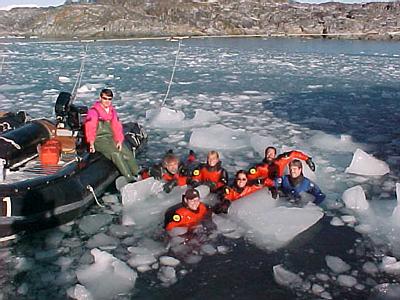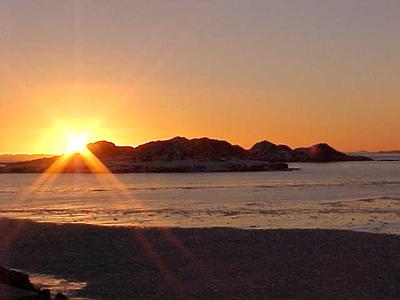27 March, 2000
Marr Glacier; Group Photo
Question 37: Where did Mt. Erebus get its name?
The last large exodus of summer crew and researchers will happen Tuesday on
the R.V.I.B. Nathaniel B. Palmer which arrived today. Everyone here is either
busy packing or helping those who are. I am talking to all the departing
people about their research and jobs. I will be putting them in future
journal entries.
Yesterday, after we returned from the ice cave, I had enough spare time to
take a hike through Palmer's backyard and up the glacier. The rocky area of
Gamage Point between the station and the glacier is referred to as the
backyard. It is one of the only places we can go alone and without a radio;
we still have to sign out on the board. Especially in the summer, people who
are here for lengthy periods of time often set up personal tents in the nooks
and crannies between the rocks and sleep away from the station. A shallow
lake in the backyard is Palmer's reserve water supply.
There is an area of the glacier marked off with flags that is relatively free
of cracks and has no crevasses that a person could fall into. The flags keep
us away from the edge of the glacier which is actively calving on both sides
of the point. We can hike, ski, snowshoe or snowboard anywhere within the
flags on our own (radio recommended). I did find one foot-sized crack that
was covered up by the new snow. It was surprisingly deep; I went in past my
knee!
As you climb up the margin of Marr Glacier it starts leveling off. The ice
cliffs around the edge of Anvers Island are anywhere from 100 to 200 feet
high. The plateau of the ice field where we can walk is around 300 feet above
sea level. Elsewhere on the island, the ice/snow field gets as deep as 2000
ft. Walking to the far end of the flagged area over endless, brilliantly
sparkling snow, I finally lost sight of the station as it disappeared beyond
the curve of the glacier.
From the far end of the flagged area you can see all of the islands in the
boating area and quite a few of the ones outside the normal boating limits.
The large mountains of the southern end of Anvers are clearly visible from
base to peak as well. Mt. Moberly is the furthest away and the tallest at
5030 ft. Mt. William is close at 4970 ft. The two are connected by a rocky
ridge. The next largest peak, Mt. Hindson, is further south and only 2670
feet tall. These are not the island's tallest mountains. To the northeast on
Anvers there is a chain of mountains topped by Mt. Francais, around 9050 or
9250 feet depending on your source, and Mt. Agamemnon, at about 8500 feet.
These two peaks are part of the same massif and can be seen over the glacier
from the station. Behind and to the south of the Anvers Island mountains, the
mountainous coast of Graham Land (the name of this area of the Antarctic
Peninsula) is visible. Its peaks are in the 3000-7000 ft range.
Before our afternoon dive, everyone in our science group (except Bruce who
does not dive) put on their drysuits and hopped into the boat harbor with the
brash ice to take a group picture. Jim will be leaving on the R.V.I.B. Palmer
so it was our last chance. It was tricky using the chunks of ice to stay in
one place without putting so much weight on them that they turned over or
scooted away. The harbor is deep; in the picture we are in water many feet
over our heads.
Answer 36: There are several volcanoes in Antarctica that have been active in
recent times. In the South Shetland Islands (off the tip of the Antarctic
Peninsula) the volcano on Bridgeman Island was active in 1822 and 1880, and
the Deception Island volcano was active most recently between 1967 and 1970.
Mount Melbourne is an active volcano on the western edge of the Ross Sea
(about 74 degrees S). And probably the best-known Antarctic volcano, Mount
Erebus, is over 12,000 feet tall and erupted as recently as 1991. It is
located on Ross Island in the Ross Sea.

Crack covered by snow on the glacier. Look at the upper part of the picture to figure out what happened!

Mt. William from the top of Marr Glacier.

View towards the southwest from Marr Glacier: Bonaparte Point to the left, with DeLaca Island and Janus Island straight out; then Palmer Station on Gamage Pt. with Torgersen Island and Litchfield Island off to the right.

Edge of Marr Glacier on Arthur Harbor.

Science Group 022 in the brash ice (L to R): Bruce Furrow, Bill Baker, Andy Mahon, Katrin Iken, Joanna Hubbard, Chuck Amsler, and Jim McClintock.

Sunset over Litchfield and Torgersen Islands.

Contact the TEA in the field at
.
If you cannot connect through your browser, copy the
TEA's e-mail address in the "To:" line of
your favorite e-mail package.
|
